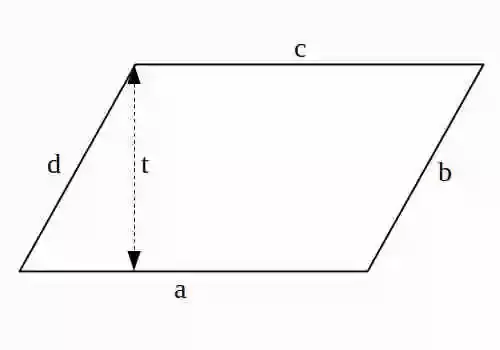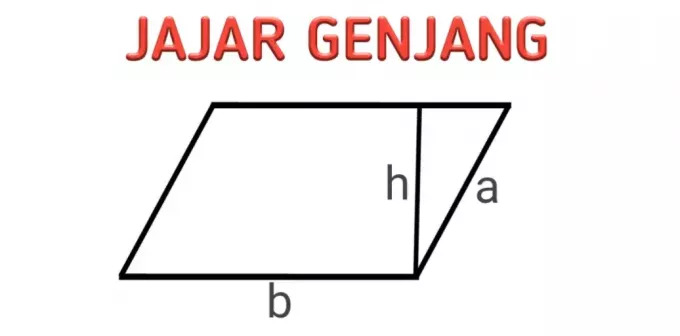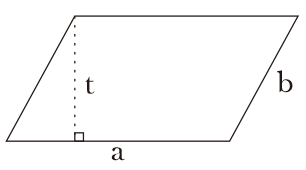Parallelogram: Area and Perimeter Formulas & Example Problems
Loading...
A parallelogram is one type of flat shape in the form of a two-dimensional quadrilateral with each side parallel to each other found in basic mathematics lessons. To find the area and perimeter of a parallelogram, you must first know the formula for a parallelogram.
A parallelogram has several characteristics that characterize it, such as the two opposite sides of the same length and parallel, and adjacent angles. In addition, there are also parallelograms with diagonal sides, but in the center of the plane they intersect.
List of contents
Definition of Parallelogram

A parallelogram or parallelogram is a two-dimensional flat shape formed by two pairs of edges with each side parallel and the same length, and has two equal angles. Parallelograms are categorized as derivatives of quadrilaterals with special characteristics.
Unlike other flat shapes, parallelograms have some special characteristics that can make it easier for you to recognize them. So, what are the characteristics of a parallelogram? Here's the answer!
- Have opposite sides, for example AD is opposite BC.
- The opposite angles of a parallelogram are congruent.
- The opposite sides are called congruent.
- If one angle is a right angle, all other angles are right angles.
- The angles of successive parallelograms are complementary to each other.
- Each diagonal divides the parallelogram into two congruent triangles.
- The diagonals bisect each other.
Read: Geometry
Types of Parallelograms

In Mathematics, parallelograms are divided into three types, namely as follows:
- Parallelograms with angles close to each other up to 180 degrees.
- A parallelogram that has opposite sides and is the same length and parallel.
- A parallelogram with the diagonals intersecting at the center.
Read: Two-dimentional figure
Parallelogram Formula

It should be noted that the formula for a parallelogram consists of several categories. You can choose to use one of the formulas according to the questions and needs. In order not to solve the problem incorrectly, below is the complete formula for a parallelogram that you need to know:
- The formula for finding the area of a parallelogram: a x t
- The formula for finding the perimeter: 2 x p + 2 x l or 2 x (a+b)
- Formula to find base: (K/2) – b or L/t
- The formula for finding the hypotenuse: (K/2) – a
- Formula to find height: L/a
- Equation formula: e2 + f2 = 2. (a2 + b2)
- Interior angle formula: a = y, b = d, a + b = 180o
Read: Linear Equations and Inequality
Parallelogram Area Formula

To find the area of a parallelogram, you can use the following formula:
L = a x t
Information:
L: Area
A: Alas
T: Height
In this formula, a is the opposite side. Therefore, a does not always mean the base, but refers to the presence of one side facing each other and having the same length.
Read: Cut the rice cake
The formula for the perimeter of a parallelogram

Meanwhile, to find the perimeter of a parallelogram, you can apply the formula below:
K = 2 x p + 2 x I
or if adjusted to the drawing,
K = 2 x a + a x BC OR a x AD
Information:
K: Around
Q: Length
I(l): Width
The formula for finding the perimeter of a parallelogram is also written as:
2 (length + width)
Read: Cube Surface Area
Example Problem Formulas for Area and Perimeter of Parallelograms
After knowing the complete parallelogram formula, you may still have difficulty solving a problem. So as not to feel confused, below are some questions regarding the formula for the area and perimeter of a parallelogram along with the discussion or answer.
1. Problem 1

It is known that a parallelogram has a base of 10 cm, a height of 5 cm, and a hypotenuse of 7 cm. Calculate the area and perimeter of the parallelogram.
Is known:
a = 10 cm
b = 7 cm
h or t = 5 cm
Asked:
What is the area and perimeter of the parallelogram?
Answer:
L = a x t
= 10 x 5 = 50 cm2
K = (2 x a) + (2 x b)
= (2 x 10) + (2 x 7)
= 20 + 14
Advertisement
= 34 cm
So, the area of the parallelogram is 50 cm2 while the perimeter of the parallelogram is 28 cm.
2. Problem 2

A parallelogram has a base of 30 cm and a height of 10 cm. Calculate the area of the parallelogram!
Answer:
L = base x height (a x h)
= 30 x 10
= 300
So, it is known that the area of the parallelogram is 300 cm2.
3. Problem 3

If a parallelogram has an area of 200 cm2 and the base is 20 cm, then what is the height of the parallelogram?
Is known:
L = 200 cm2
a = 20 cm
Asked:
Parallel height?
Answer:
L = a x t
200cm2 = 200 cm x h
t = 200 cm2 / 20 cm
t = 10 cm
So, it is known that the height of the parallelogram is 10 cm.
4. Question 4
It is known that a parallelogram has an area of 350 cm2. If the length of the base is 5x and the height is 3x, find the value of x, the length of the base, and the height of the parallelogram.
Discussion:
To find the value of x, you can use the formula for the area of a parallelogram, which is
Area: base x height (a x h)
350 cm2 = (5x) x (3x)
350 cm2 = 15x2
x2 = 35 cm
x = 7.5 cm
After the value of x is found, then the length of the base of the parallelogram can be found by:
Base length = 5x
Base length = 5 x 7.5 cm
Base length = 37.5 cm
In the same way, we can find the height of the parallelogram, namely:
Height = 3x
Height = 2 x 7.5 cm
Height of parallelogram = 15 cm
5. Question 5

In the parallelogram ABCD, it is known that AB is 10 cm and AB: BC = 5: 2 and height = 5 cm, then calculate the perimeter and area of the parallelogram.
Discussion:
In finding the perimeter of ABCD, you must first find the length of BC by applying the concept of comparison, namely:
AB: BC = 5: 2
10cm: BC (5:2)
BC = 2/5 (10 cm)
BC = 2/5 (10 cm)
BC = 4 cm
With the length of BC, we can find the perimeter of the parallelogram, namely:
Perimeter = 2 (B=BC0
Perimeter = 2 (10 cm + 4 cm)
Perimeter = 2 (14 cm)
Perimeter = 28 cm
Meanwhile, to find the area of a parallelogram, you can use the following formula:
Area = a x t
Area = 10 cm x 5 cm
Area = 50 cm2
By knowing and understanding how to use the parallelogram formula. Now you will not find it difficult to do math problems related to parallelograms. Moreover, above have given examples of problems and how to solve them.
X CLOSE
Advertisements
ADVERTISEMENT
X CLOSE
